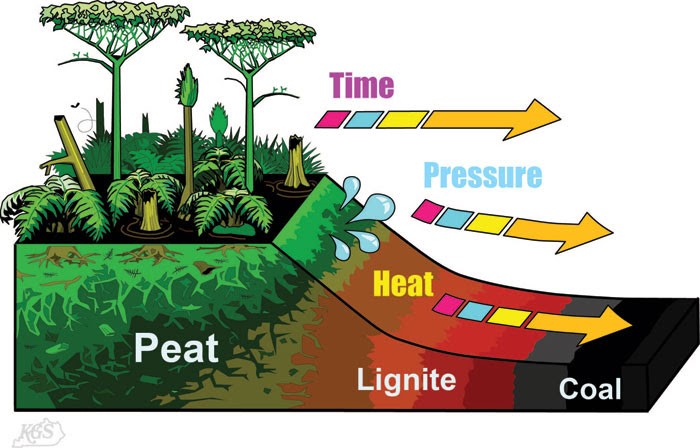Ahmedabad
(Head Office)Address : 506, 3rd EYE THREE (III), Opp. Induben Khakhrawala, Girish Cold Drink Cross Road, CG Road, Navrangpura, Ahmedabad, 380009.
Mobile : 8469231587 / 9586028957
Telephone : 079-40098991
E-mail: dics.upsc@gmail.com

Coal shortage in India
News: India’s thermal power plants are facing a severe coal shortage, with coal stocks having come down to an average of four days of fuel across an increasing number of thermal stations.
Coal
• This is the most abundantly found fossil fuel. It is used as a domestic fuel, in industries such as iron and steel, steam engines and to generate electricity. Electricity from coal is called thermal power.
• The coal which we are using today was formed millions of years ago when giant ferns and swamps got buried under the layers of earth. Coal is therefore referred to as Buried Sunshine.
• The leading coal producers of the world include China, US, Australia, Indonesia, India.
• The coal producing areas of India include Raniganj, Jharia, Dhanbad and Bokaro in Jharkhand.Coal is also classified into four ranks: anthracite, bituminous, subbituminous, and lignite. The ranking depends on the types and amounts of carbon the coal contains and on the amount of heat energy the coal can produce.
Present Coal Shortage:
• Economy recovering from the Covid-19 pandemic coupled with supply issues have led to the current coal shortage.India is suffering from the impacts of a sharp surge in electricity demand, a squeeze on domestic mine output and surging prices of seaborne coal.
• Coal fired thermal power plants have also supplied a higher proportion of the increase in demand leading the share of thermal power in India’s power mix increasing to 66.4% from 61.9% in 2019.
• Lower than normal stock accumulation by thermal power plants in the April-June period and continuous rainfall in coal bearing areas in August and September which led to lower production and fewer despatches of coal from coal mines.A consistent move to lower imports coupled with high international prices of coal have also led to plants cutting imports.
• If Industries face electricity shortages, it could delay India’s economic reopening.Some businesses might downscale production.Providing India's population and underdeveloped energy infrastructure, the power crisis could hit long and hard.
• Commercial mining of coal allowed, with 50 blocks to be offered to the private sector.Entry norms will be liberalised as it has done away with the regulation requiring power plants to use “washed” coal.
• Coal blocks to be offered to private companies on revenue sharing basis in place of fixed cost.Coal gasification/liquefaction to be incentivised through rebate in revenue share.Coal bed methane (CBM) extraction rights to be auctioned from Coal India’s coal mines.
Challenges:
• Coal is the most important and abundant fossil fuel in India. It accounts for 55% of the country’s energy needs. The country’s industrial heritage was built upon indigenous coal.
• Commercial primary energy consumption in India has grown by about 700% in the last four decades.
• The current per capita commercial primary energy consumption in India is about 350 kgoe/year which is well below that of developed countries.Driven by the rising population, expanding economy and a quest for improved quality of life, energy usage in India is expected to rise.
• Considering the limited reserve potentiality of petroleum & natural gas, eco-conservation restriction on hydel project and geo-political perception of nuclear power, coal will continue to occupy centre-stage of India’s energy scenario.
Way forward:
• Government is working to closely monitor stocks and also State run Coal India and NTPC are working to raise output from mines to boost supply.Rationing domestic power supplies, especially in rural and semiurban areas, may emerge as one of India’s easiest solutions.
• Indian power distributors do typically cut supplies to certain areas on a rotational basis when generation is lower than demand, and an extension of load-shedding would likely be considered if power plants take any further hits.
• India will need to amplify its imports despite the financial cost. From Indonesia for instance, the price rose from USD 60 per tonne in march to 200 per tonne in September.
• The same monsoon rains that have flooded coal mines are likely to boost hydro-power generation.
• Large hydro-electric projects on dams are India’s major electricity source after coal and the sector performs at its peak around the rainy season which typically extends from June to October.
• There could be a larger role for natural gas to play, even with global prices currently surging.
• In a desperate situation, the gas-powered fleet could help prevent any widespread power outages. Staterun generator NTPC Ltd., for example, has idle capacity that can be fired up in around 30 minutes if needed and is connected to a gas grid.

Address : 506, 3rd EYE THREE (III), Opp. Induben Khakhrawala, Girish Cold Drink Cross Road, CG Road, Navrangpura, Ahmedabad, 380009.
Mobile : 8469231587 / 9586028957
Telephone : 079-40098991
E-mail: dics.upsc@gmail.com
Address: A-306, The Landmark, Urjanagar-1, Opp. Spicy Street, Kudasan – Por Road, Kudasan, Gandhinagar – 382421
Mobile : 9723832444 / 9723932444
E-mail: dics.gnagar@gmail.com
Address: 2nd Floor, 9 Shivali Society, L&T Circle, opp. Ratri Bazar, Karelibaugh, Vadodara, 390018
Mobile : 9725692037 / 9725692054
E-mail: dics.vadodara@gmail.com
Address: 403, Raj Victoria, Opp. Pal Walkway, Near Galaxy Circle, Pal, Surat-394510
Mobile : 8401031583 / 8401031587
E-mail: dics.surat@gmail.com
Address: 303,305 K 158 Complex Above Magson, Sindhubhavan Road Ahmedabad-380059
Mobile : 9974751177 / 8469231587
E-mail: dicssbr@gmail.com
Address: 57/17, 2nd Floor, Old Rajinder Nagar Market, Bada Bazaar Marg, Delhi-60
Mobile : 9104830862 / 9104830865
E-mail: dics.newdelhi@gmail.com